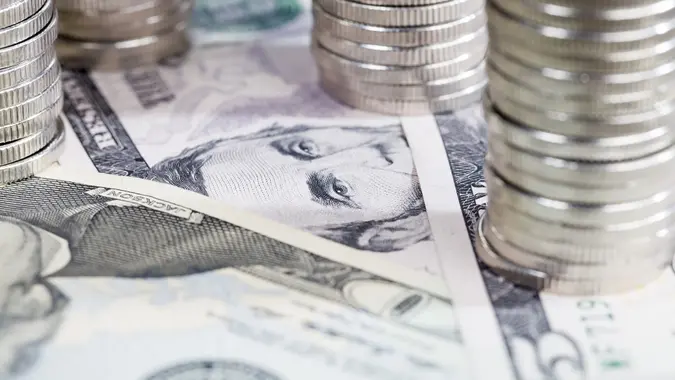Can You Find a 7% CD? What You Need To Know

Commitment to Our Readers
GOBankingRates' editorial team is committed to bringing you unbiased reviews and information. We use data-driven methodologies to evaluate financial products and services - our reviews and ratings are not influenced by advertisers. You can read more about our editorial guidelines and our products and services review methodology.

20 Years
Helping You Live Richer

Reviewed
by Experts

Trusted by
Millions of Readers
Usually, after you get your standard savings account rates or checking accounts, you start to branch out into accounts that can give you the highest interest rate. The next natural step is often to open a certificate of deposit, at the bank or credit union you use. As the national average for CD rates is around 1.82%, it does make you wonder if getting a 7% CD account is even possible.
In this article, GOBankingRates covers whether or not 7% are the real thing, any risks involved and what you can choose as an alternative.
What Are 7% CDs?
A 7% CD would offer 7.00% annual percentage yield on your investment. Once the term ends, you can collect both the principal and the interest you’ve earned. You can then choose to reinvest it into the same CD term, withdraw it to use, or invest it elsewhere.
A 7% CD does have a high APY offering, which is often higher than what you might find with a standard CD. Higher APY rates are often found at online banks or credit unions, than at traditional banks. Brick-and-mortar traditional banks, while widely available and have relatively easy branch access, tend to provide lower rates compared to the national average, prioritizing convenience and accessibility to customers.
Are 7% CD Rates Real?
At this time, most banks are not offering a 7% CD rate. So you might not be able to find a CD with that high of an APY rate at the moment.
CDs could offer 7.00% APY during periods when the Federal Reserve interest rates. A bank may decide to raise their rates as a promotion or for a limited-time offer. At this time, most banks are offering CDs around the 4% APY range, give or take.
Be wary of places that advertise rates that seem too good to be true–scams are rampant when it comes to money. You’ll want to open an account with a reputable bank or credit union that’s FDIC or NCUA-insured. You could see this GOBankingRates’ list of the best CD rates to get an idea of some of the best banks and institutions offering competitive rates.
However, no matter your financial goals, earning 7% APY on a CD account will get you there faster. But before opening any CD account, you need to be aware of the CD terms, minimum opening deposits, fixed interest rates and early withdrawal penalties.
Pros and Cons of 7% CDs
There are many advantages and disadvantages to a 7% CD. Here’s a look:
Pros
There are advantages to a 7% CD, such as:
- High interest rate: A 7% rate is an attractive investment opportunity for many individuals. It’s hard to get that rate with a traditional savings or money market account.
- Guaranteed return: A CD is at a fixed rate and you will be able to know how much you will receive at maturity.
- FDIC insured: CDs are typically FDIC insured. The insurance covers up to $250,000 and is protection on your principal and interest in the case the bank fails.
- Low risk. CDs are a low risk investment compared to stocks.
- Easy to manage: A CD doesn’t require ongoing management and is great for those who want to embrace a hands-off approach.
Cons
The 7% CD presents disadvantages too. Here are some to consider:
- Limited liquidity. Your money is generally locked up for the entire term, which leaves little room for flexibility if you need your money quickly.
- Early withdrawal penalties: If you withdraw from a CD before its maturity date, you’ll incur an early withdrawal penalty.
- Potential to lose out on investments. You could lose out on a higher interest rate since you’re locked into a fixed interest rate.
- Inflation: Inflation can reduce your CD’s value.
Who Should Consider a 7% CD?
CDs are excellent if you’re not the risky type of investor. With CDs, you have a fixed rate, so you know exactly how much you can collect once the term ends.
Before locking yourself into a 7% CD, or any CD for that matter, you may want to consider the following:
- Duration and term length: CDs usually come with a term length that can range from months to years. Whatever length you choose, make sure you’re comfortable with the time frame. Withdrawing prior to the designated length may result in a penalty.
- Early withdrawal penalty: CDs have early withdrawal penalties if you need funds before the maturity date.
- Automatic renewal: Your CD may automatically renew. If you want to pull out these funds, review the bank’s renewal policy. There may be a grace period stipulating when you can withdraw funds.
- Minimum deposit required: Most CDs have a minimum deposit that is required. It may range from a few hundred dollars to a higher amount.
- Consider market conditions: If you have a CD at a fixed interest, you won’t be able to benefit from market fluctuations.
- FDIC insurance: Ask if your CD is FDIC insured. The insurance will typically cover up to $250,000 per depositor, per insured bank, for each account category.
- Callable CD: Some banks can “call” your CD especially if the interest rate decreases. This means the bank can redeem the CD before the maturity date. Ask if your CD is callable.
- Ask about interest: Ask how frequently interest rate compounds on your CD (daily, monthly, yearly). More frequent compounding can increase your returns.
FDIC Insurance and CD Safety
FDIC insurance ensures that your CD is protected up to $250,000. This protection makes a CD a low risk investment. In the event a bank fails, FDIC insurance protects both the principal, which is the original amount deposited, and any interest earned, up to the insured limit.
If you plan to have multiple CDs at one institution, make sure that the total doesn’t exceed the $250,000 limit. To have extended coverage, you could have CDs across multiple FDIC-insured banks or account types that can extend your coverage.
How Inflation Impacts CD Returns
Inflation can impact your CD’s buying power, even if the interest rate on the CD is high. The real return on a CD is the nominal interest rate (stated rate) minus the inflation rate. If your CD offers a 7% return, but inflation is 5%, your real return is only 2%. This effectively reduces the value of your earnings.
Here’s how inflation specifically impacts your CD:
- Value of earnings is diminished. If inflation is high, the real value of your interest earnings declines because the cost of goods and services is rising faster than the rate at which your money grows.
- Fixed rate is a disadvantage. CDs offer a fixed rate of return and that provides stability; it also prevents you from taking advantage of other investments with variable or inflation-adjusted returns which might offer a better hedge against inflation.
- Impact on long-term CDs. With long-term CDs, you’re locked into a fixed rate for a longer period, which can be a drawback if inflation continues to rise.
Tax Considerations on a 7% CD
Earning a 7% return on a CD can have tax implications, as interest income from CDs is generally considered taxable.
- Taxable as ordinary income. The interest you earn on a CD is considered ordinary income. You are subject to federal income tax, as well as state and local income taxes.
- Pushes you into a higher tax bracket. With a high interest rate like 7%, the interest income can increase your taxable income significantly, potentially pushing you into a higher tax bracket.
- Increase in Social Security taxes. The additional interest income from a high-yield CD could increase the taxable portion of your Social Security benefits.
Penalties for Early Withdrawal
If you withdraw funds from your CD prior to maturity, you will incur penalties for an early withdrawal. Here are some general guidelines on the penalties you may incur
- Short-term CDs. Early withdrawals on short-term CDs (less than 12 months) is 90 days of interest on the amount withdrawn.
- Medium-term CDs. Early withdrawals on medium-term CDs (one to three years) is 180 days of interest on the amount withdrawn. For example on a $10,000 CD at 7% APY, you’d lose $350 in interest for an early withdrawal.
- Long-term CDs. For long-term CDs (four years or more), the penalty can be as high as 12 months of interest or more, depending on the financial institution.
Do Early Withdrawals Impact Your CDs Balance?
- Interest Not Accrued. If you withdraw very early into the term, the penalty may exceed the interest earned up to that point, potentially resulting in a reduction of your principal.
- Penalty Deducted from Principal. Some banks may deduct the penalty directly from your principal if accrued interest doesn’t cover the full penalty, especially for withdrawals made within the first few months.
Alternatives to 7% CDs
No banks and financial institutions are offering 7% CDs. However, there are several alternative investments that offer high returns:
1. High-Yield Savings Accounts
These accounts offer higher interest rates than traditional savings accounts. Current rates hover around 4.5% to 5%. These accounts provide the flexibility to withdraw funds without incurring a penalty. The downside is that rates are variable and can change if the Federal Reserve lowers rates.
2. Money Market Accounts
A money market account is similar to a savings account, but also offers check writing capabilities and debit card access. You can think of these as kind of a middle ground between savings and checking accounts. A money market account is currently boasting an interest of up to 5.05%. Money market accounts typically require a high minimum balance and have limited transaction capabilities.
3. Treasury Securities
You can invest in U.S. treasury bills, notes and bonds. These are government-backed securities with varying maturities. Current one-year treasury bills yield around 4.3%. Treasury securities come with low risk and are generally exempt from state and local taxes. You may receive a lower yield compared to some CDs and savings accounts.
4. No-Penalty CDs
A no-penalty CD allows you to withdraw funds without incurring a penalty. The interest rate is lower than traditional CDs, but typically higher than savings accounts. Some banks may not allow you to partially withdraw money from your no-penalty CD and may ask you to withdraw the full amount.
5. Dividend Paying Stocks
Dividend paying stocks offer regular distributions of earnings to its stockholders. There’s potential to earn regular income, but that depends on the market’s volatility. Earnings are not guaranteed.
Other CD Accounts With High APYs
Though a 7% CD account would be great, if it’s not available in your area, there are still banks and credit unions offering APYs between 4% and 6% APY. APYs in this range are well above the national average. If you are looking for a high APY, you could consider some of the following accounts with varying maturity dates:
- American Express® National Bank, Member FDIC, 12-month CD: Annual Percentage Yield (APY)
- Barclay’s Bank 12-month CD: APY
- Capital One 18-month CD: APY*
- Discover Bank, Member FDIC: 2-year CD: APY
- Tab Bank 1-year CD: APY
Final Take
When it comes to earning money on a CD or savings account, the general consensus is that, though all saving is important, you should go big or go home. Research the accounts that local banks or credit unions are offering and what you can earn on your money.
FAQ
Here are the answers to some of the most frequently asked questions regarding CD accounts.- Are 7% CDs insured by the FDIC or NCUA?
- Yes, 7% CDs–and typically most CDs–are insured, as long as the institution that offers the accounts is backed by FDIC or NCUA insurance. Banks typically carry FDIC insurance, while credit unions are NCUA-insured. FDIC and NCUA insurance will cover $250,000 for each account, each institution, on CDs, as well as other deposit accounts.
- What is the minimum deposit for a 7% CD?
- The minimum deposit for a 7% CD depends on the financial institution. Some banks might not require a minimum deposit on their CDs, whereas others do. For example, you’ll need at least $1,000 to open a CD account at Chase, but Capital One does not have a minimum deposit requirement. However, it should be noted that no institutions are offering a 7% CD at this time.
- Can I withdraw my money early from a 7% CD?
- You can withdraw your money at any time, including from a 7% CD, but note you may have to pay early withdrawal fees by doing so.
- Are 7% CDs better than high-yield savings accounts?
- A 7% CD can be more lucrative than a high-yield savings account if the interest you earn on the CD outpaces the high-yield savings account’s rate. In general, though, a CD could be a great investment depending on your needs. You get a fixed rate, so a guaranteed return on your investment, even if rates overall drop. The rate on a high-yield savings account could drop with the market. Plus, you can save for a long-term goal.
- What are the risks of investing in a 7% CD?
- 7% CDs are not available at any banks at this time, so be cautious of any offers advertising rates that high. Always open an account with a trusted and reputable bank, credit union or financial institution that’s FDIC or NCUA-insured, regardless of your CD rate.
Melanie Grafil and Caitlyn Moorhead contributed to the reporting for this article.
Rates are subject to change; unless otherwise noted, rates are updated periodically. All other information on accounts is accurate as of Jan. 28, 2025.
*Capital One interest rates accurate as of Jan. 28, 2025. See website for all current rates.
All information about American Express CD accounts has been collected independently by GOBankingRates and has not been reviewed or approved by American Express. These offers are not available through GOBankingRates.
Editorial Note: This content is not provided by any entity covered in this article. Any opinions, analyses, reviews, ratings or recommendations expressed in this article are those of the author alone and have not been reviewed, approved or otherwise endorsed by any entity named in this article.
Editorial Note: This content is not provided by American Express. Any opinions, analyses, reviews, ratings or recommendations expressed in this article are those of the author alone and have not been reviewed, approved or otherwise endorsed by American Express. American Express credit card products are not available through GOBankingRates.com.
Our in-house research team and on-site financial experts work together to create content that’s accurate, impartial, and up to date. We fact-check every single statistic, quote and fact using trusted primary resources to make sure the information we provide is correct. You can learn more about GOBankingRates’ processes and standards in our editorial policy.
- Business Insider. 2023. "What is the average interest rate for CDs?"
 Written by
Written by  Edited by
Edited by 

























